Looking after a reef tank at home requires dedication, profound knowledge, and having the right equipment.
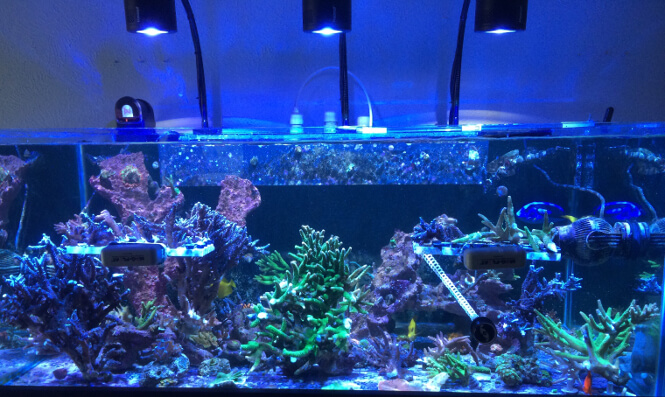
Through my experience, I’ve come to the conclusion that the best LED aquarium lighting systems for growing corals are not always the most obvious premium brands.
SPS, LPS, and soft corals need different light intensities to grow and this should also be taken into account when choosing adequate lights.
Also, would you be able to achieve satisfactory growth if you purchase a relatively cheap LED grow light?
In this guide on the top reef tank lights and their specifics, I answer all the questions a beginner may have.
So let me show you what the best LED aquarium lighting systems are and which ones will be perfect for the corals in your new reef tank.
Beginner’s guide on LED lighting and its impact on a Coral reef aquarium
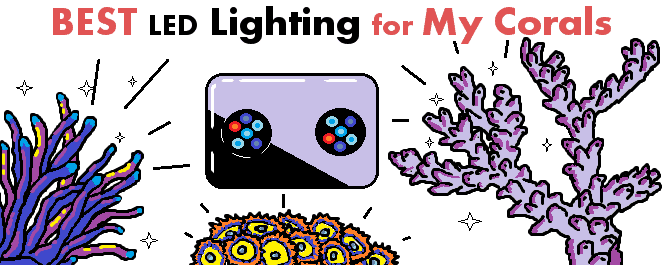
To supply your saltwater reef tank with adequate LED lighting you’d want to be familiar with how both worlds operate. I’ve taken all of that information into consideration when listing the best options for your tank anyway.
But if you’re a beginner in keeping marine fish and corals and are curious how I got the answers – read here as I will walk you through everything you’d need to know before making a choice.
I recommend bookmarking this page, because there are quite a few things to be said, and you may find yourself coming back for future reference:
1. The aquarium’s dimensions affect how easy it is for light to penetrate water
One of the most important things I learned throughout my reef tank journey was the following:
Your reef aquarium’s dimensions will have a direct impact on how well your LED lights work for the corals.
By dimensions, I really mean depth, because light has a limited water penetration.
You’ll want all of your corals to thrive, from top to bottom.
Author’s note:With freshwater aquariums, the gallon capacity of a tank can be a relatively effective benchmark for the depth of an aquarium. In that part of the hobby, the most-used tanks have standard aquarium dimensions. For example, in 99% of the cases, a 55-gallon freshwater aquarium would have a depth of 21 inches (53.3 cm).
However, in the saltwater part of the hobby, most tanks have an unconventional form and their dimensions and depth can greatly vary.
For this reason, I think it would make a lot more sense to base my LED lighting recommendations on aquarium depth and not the gallon capacity of your reef tank.
2. Kelvins are relatively irrelevant
It’s really time to bust this myth up as I did in my review article about planted tank lighting.
Before deciding on how many Kelvins the LED lights for your new saltwater tank should employ, you first need to understand what Kelvins really are.
Let me explain:
In reef-keeping communities, it is often said that your lighting should be at least 7000 K where some say that it should go up to 10 000 or even 12 000 K.
However, my experience has been that the K-rating of a lighting fixture or a bulb has nothing to do with growing corals.
Kelvin ratings are essentially the color temperature of a black body that’s emitting light under heat.
So, our sun is a star that burns at 5700 K and because of our atmospheric layer, its light appears white. A star that burns at 12 000 K will give off blue-ish light. If the burning temperature of a black body drops to anywhere between 3000 and 2700 K we get yellow or “warm” light and so on.
Reef corals are known to best employ blue light for their growth. For this reason, in the past, it was assumed that the best candidate for reef tank lighting would have high Kelvin ratings.
Makes sense so far, right?
Not so fast.
What a few of us know is that the estimated Kelvin ratings of LED lighting are based on a metric called Color Correlated Temperature, or CCT for short.
CCT makes sure that manufacturers have a unified reference for what the color of their lights should emit. The lighting should mimic the color temperature of actual black bodies that emit light when burning.
It all comes down to how that’s perceived color by the human eye, however.
This means that a lighting fixture that has an estimated K-rating of 5800 Kelvins will give off the same color of light as a body that burns at that temperature. The light bulb or diode itself won’t literally burn at the staggering temperature of the surface of our Sun!
That’s called a color shift. Because of this LED lighting manufacturers have to tweak their products to make sure a 5000 K lamp emits what a 5000 K should, according to CCT.
With all that said, here’s how the Kelvin rating of aquarium lighting affects the growth of corals:
Kelvin ratings mimic how the human eye would perceive the color of black bodies burning at a given temperature. Therefore, in LED lighting the estimated Kelvin ratings play a role in chromatic aesthetics and how they appear to humans but do not impact the growth of corals in the aquarium.
Though light for most reef corals should have a great portion of the blue spectrum, Kelvin ratings do not adequately represent that.
The wavelength of the light does.
Looking for better coral coloration? Check out this detailed guide on coral food recommendations.
3. Making sense of PAR and PUR
Once LED lighting emerged as commercially available in the saltwater aquarium industry, quite a few people remained skeptical about it.
I remember that back then it was all about metal halides and T5s (types of aquarium lighting).
The ongoing “strategy” was to blast the photosynthesis out of our corals with super intense light and hope for the best.
Right after the “watts per gallon” mania, more sophisticated users, or perhaps the efforts of some savvy marketing department, introduced the PAR measurements.
PAR stands for Photosynthetically Active (or Available) Radiation. It represents the spectrum of wavelengths between 400 and 700 nanometers, which is utilized by organisms for their photosynthesis processes.
PAR is measured in Photosynthetic photon flux density or PPFD in short.
So the narrative was that the more PAR the bulb would produce, the better it would be for the corals beneath.
There is some truth to this claim but that’s just part of the equation for coral growth.
Before it gets confusing I will clarify that, essentially, PAR readings would measure the quantity of light that is being received by an area.
For corals, the PAR levels should be enough not to starve the photosynthetic algae. At the same time, they should not be too high to cause what’s known as coral bleaching (discoloration) and damage to the corals.
Observations of marine reefs show that balance is key with PAR.
Different species of saltwater plants or coral algae will utilize different chunks of wavelengths in the PAR spectral range for optimal growth.
These chunks are defined by what’s called PUR.
Let me define PUR really quickly:
The specific set of wavelengths contained somewhere in the range of 400 to 700 nanometers that trigger photosynthesis in a particular photosynthetic organism – that’s PUR or Photosynthetic Usable (Utilizable) Radiation. These vary for different organisms.
You could have an LED lighting fixture that produces enough PAR, but if that’s in the wrong spectrum, say, yellow to orange, then it would not be beneficial to the growth and color of marine corals.
The beauty of LED lighting is that its manufacturers have control over what diodes they install on their fixtures, which reflects the PUR spectrum better.
Author’s note: Efficient LED grow lights would provide the right PUR portion of the PAR they emit. This eliminates the need for pumping up the light intensity beyond belief as some PAR fanatics in the hobby would want you to do. This is the reason why you could see LED lights that would actually grow corals better than the older metal halides which had immense power.
Typically, good reef lighting produces a lot of PUR per PAR.
This keeps the costs down, while actually producing more coral growth and color than ever.
Anyhow, the LED lights that I’ve listed have been tested and proven to grow marine corals like weeds by the thousands of people that use them.
This is because the lights produce not only PAR but also the efficient kind of blue-ish spectrum PUR that’s beneficial for the development of colorful and massive corals.
Though manufacturers have gotten extremely good at nailing the right kind of diodes, most models will come with a customizable spectrum and settings.
This is done in order to provide reef-keeping aquarists with more flexibility because there is a wide range of corals to be grown.
Which dictates my next section.
4. Discovering the best spectrum and LED light settings for a successful reef tank
So spectrum in the context of lighting is defined as the specific wavelength range the incoming light falls in.
So, going back to PUR, different spectra affect corals differently, even at the same light intensity.
Since most LED reef lights come with a customizable spectrum, I will need to discuss the settings further.
The electromagnetic spectrum that can generally trigger photosynthesis (PAR, again) pretty much overlaps with visible light.
Here’s an illustration of that:

The shorter the wavelength of light is, the higher the frequency of the wave. Here’s a visual representation of that:

Now, higher frequency means higher energy when it comes to waves.
Typically, the more energy you have the better you are at pushing through things. In our case, I am looking at water penetration.
Logically, the larger wavelengths such as red light (630 to 700 nanometers) get absorbed by water almost instantly and have the most limited reach within it.
Of all the PAR, blue light chunk (435 to 495 nanometers) will have the strongest water penetration.
The blue wavelength reaches around 12 times deeper in ocean water than red light.
You can clearly see different spectra and how deep they penetrate water illustrated here:
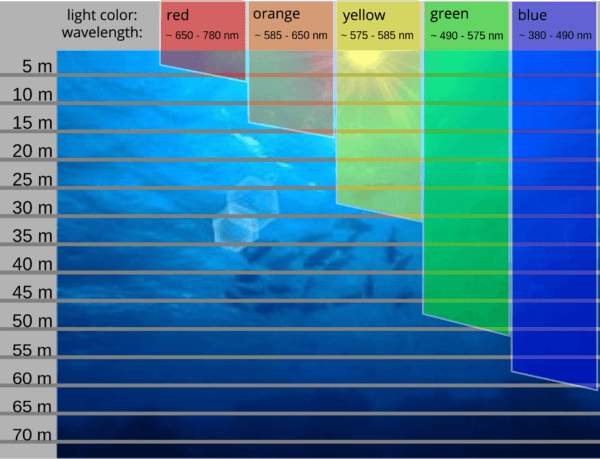
Scientists agree that blue light has the biggest impact on coral growth.
This makes sense because corals are rarely found 2 meters (6’6.74″) or less underneath the water surface.
However, you can see reefs completely dominating areas at 5 to 6 meters deep (around 19’8″), and you can also see established reef colonies at more than 40 meters deep (over 131 feet).
The scientists collected the same species of coral (Stylophora pistillata) from various depths of between 3 and 30 meters.
Then they illuminated each sample with the same PAR and photoperiod, but with different spectra.
Here’s what they found:
The corals closer to the water surface responded with better photosynthetic rates to full-spectrum, white light.
However, the ones that were collected from the deep waters had a better photosynthetic reaction to a heavy blue-filtered light spectrum in the 400 to the 500-nanometer range.
Here are my 2 major takeaways from this study:
- Corals are greatly adaptive to the incoming light spectrum, even the same species.
- The coral’s location prior to collecting it matters for choosing the right settings on your reef tank’s LED lights.
This means that, in theory, there is simply no best settings for a perfect reef aquarium lighting.
For example, most hard stony corals with small polyps – also known as SPS corals – are found in the depth range of between 10 and 100 feet (3 to 30 meters).
Since their required PAR also decreases with water depth a silver-bullet light intensity settings should not really exist.
In practice, however, there are some general rules to be followed that would give you a very decent start in growing a reef under LED lighting:
If the corals you want to grow have been collected from shallower waters (up to 6 meters or 19 feet) then you’d want to set your aquarium’s LED lighting to full spectrum light and you should ramp up the intensity. This would generally mean a 1:1 ratio of the blue to white light channels, respectively.
If the reef corals you’re looking after have been collected from deeper waters of 10 and more meters (33 feet or more) then set the spectrum of your LED lights at 6:1 blue to cool white wavelengths.
You’ll rarely find commercially available corals obtained through diving.
It makes much more sense for the seller to start their own coral farm. Going deep down the ocean can be costly for both the vendor and the buyer.
So since you’ll most likely be buying aquarium-grown reef corals, you should try to mimic the light settings of the vendor’s tank. So just ask that upon purchase.
Author’s note: Though corals are super adaptive, they will need weeks, if not months, to get fully used to each tweak of the lighting settings.
Whatever settings you decide on – I recommend setting them and forgetting them.
Regular tweaks of your LED lighting settings will result in low survival rates of the corals, low algal density, and weak coloration patterns.
Only the intensity would be okay to play around with, and that’s still once or twice a month and in the ballpark of 2 to 5%.
5. Build of the fixture and longevity
LED lights tend to outperform other known types of aquarium lighting in terms of longevity and depreciation.
Most manufacturers state a diode life of 50 000 hours while emitting.
That’s more than 15 years on a regular photoperiod. However, the parts that would go out earlier are things such as fans and adapters.
Most of the cheaper LED fixtures will last you between 2 and 4 years and they usually come with a warranty.
The high-end products, however, can last at least 5 with good maintenance. That’s because these lights have better secondary parts.
6. External fixture appearance
Having a saltwater tank is all about the coolness and the looks.
For me, it’s very important that the lighting fixture I end up with does not spoil the overall appearance of my marine aquarium.
In my opinion, this should not have a super huge impact on your buying decision, unless you’re deciding between two products with similar specifications.
7. Should there be cool features?
I won’t lie – I do enjoy having some bells and whistles for display purposes.
The extra features can be things such as a remote controller, or weather simulation patterns where the lighting dims as if clouds were passing in the sky.
However, these features are mostly irrelevant for growing colorful corals, but if you’re like me you should probably not miss out on those.
Author’s note: I don’t include the controllability of the spectrum when I talk about cool features.
8. Flexibility and control
Though this may sound boring at first, it’s an important part of my decision when I want to find the best reef LED lights for my saltwater aquariums.
Having more control over intensity and spectrum allows me to be more flexible when it comes to both reef fish and coral, and even upgrading to a larger tank.
Most of the time you’ll end up with a product that only works at 50% intensity because LED lights have monstrous output anyway.
When you decide to upgrade your aquariums or transition over to more demanding corals – you simply ramp up the intensity and tweak the spectrum (carefully).
Do you have an issue with algae?
Remove the unnecessary light or color and you’re good to go. No need to put extra algae eaters in your reef tank in an attempt to control the nuisance growth.
Anyway, most of the LED fixtures I will list below allow control to at least some degree, as the best ones on my personal list should.
Here’s an example of a control dashboard:
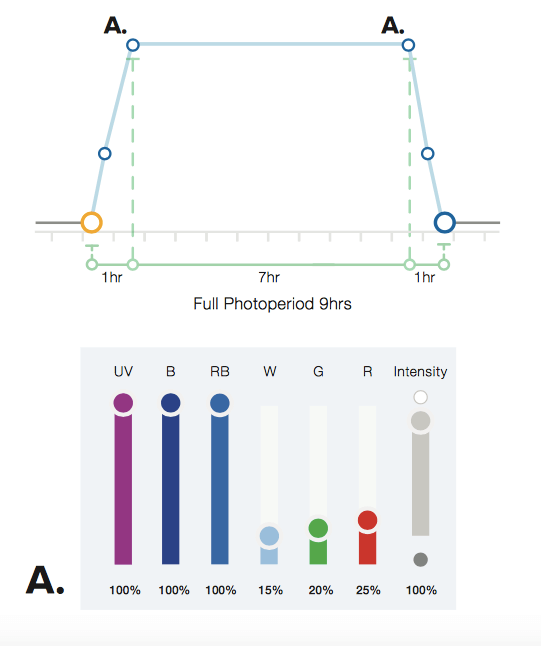
9. Color blending and aesthetics
Finally, if the diodes on your LED fixture have lenses that concentrate the beams too much your tank would get less overall color blending.
I made sure to only review models that have good color blending because there’s nothing more disappointing than having your saltwater aquarium look like a disco dance floor.
Another thing that’s worth mentioning is the shimmering effect.
A high-end LED light such as Kessil, combined with the typical flow caused by your aquarium’s powerheads, will produce a shimmering effect that appears very natural.
Though this is not needed for blooming, colorful corals, it can be a deal-breaker for people who want to build a display reef tank.
Here’s how a natural shimmer looks in a tank that is illuminated by a Kessil AP700, the predecessor of the AP9X:
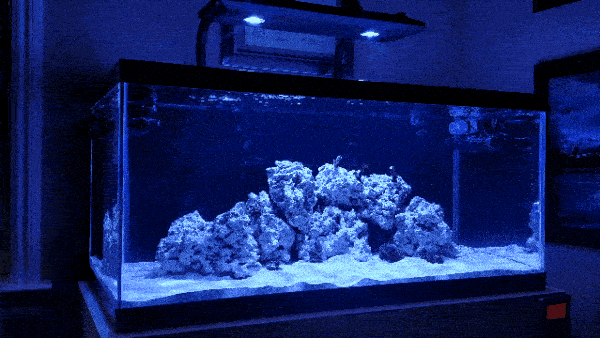
Best LED Aquarium Lighting for Corals: My 3 Top Budget Choices
Typically, you’d want an LED lighting fixture with a majority of blue diodes because more red light may suppress the corals’ growth.
Anyway, in this section, you’ll only find reviews of brands and models that have proven themselves to me personally or someone else I know in real life.
Author’s note: At first I will only list and review lights that will yield the best growth for the money. After that section, I will review and share my experience with the premium fixtures.
Have a look at the best LED aquarium lighting systems for growing reef corals:
| LED Lights: | For Aquarium Depth: | Grows: | Price Bracket: |
|---|---|---|---|
| 1. VIPARSPECTRA 165/300W | 18 to 30-inch deep tanks | SPS-dominant aquariums and mixed reefs | $$ |
| 2. Current USA Orbit Marine LED | tanks with a depth of 12 to 21 inches | Mostly LPS corals and mixed reef tanks that have a few SPS towards the top | $$ |
| 3. ABI Tuna Blue | 8 to 18-inch deep nano tanks | SPS & LPS Corals | $ |
1. VIPARSPECTRA LED Dimmable 165/300 Watts – Best for Medium to Deep Tanks with SPS Corals

Click here to see the current price + more photos on Amazon.
When I first read about this LED fixture and its application to reef aquariums I had no choice but to be absolutely skeptical about it.
What I was seeing was obviously too good to be true.
The VIPARSPECTRA LED reef light is supposed to be pretty much cost-oriented, however, the best thing about it is that it provides tons of features alongside effective results.
It has a built-in timer for 2 distinctive light channels, puts up a tremendous output PAR, has the needed PUR to grow anything from soft corals to demanding SPS ones, and has a wireless remote.
Being my fairly obsessive self I went ahead and read pretty much all reviews and reports about these particular LED lights, making sure to only take into consideration opinions from people who actually own the fixtures.
А pretty objective statement would be that my research couldn’t find a person that was unhappy with their reef aquarium’s lighting if that was a VIPARSPECTRA LED.
Moreover, many people were actually regretting their purchase of more expensive, high-end fixtures before trying this one.
Apparently, you’d be able to grow SPS corals that demand very strong lighting with the VIPARSPECTRA LED fixtures.
The intensity seems to be not just satisfying but in some cases overwhelming.
To actually have good results and not bleach your coral colonies you’ll need to position this LED light at least 10″ off the water surface.
At this mounting height, there are still some hotspots, though, so if you want to go the extra mile you can remove much of the lensing to ensure a better and more even light spread.
Removing lenses is fairly easy to do, as the unit is not particularly complicated to open and play with. I did it when I got mine and I don’t even consider myself a handy person.
Speaking of light spread, the effective coverage for each fixture is approximately 2 feet in any direction.
Anyway, with these LED lights, there’s no ocean-like shimmering, but there’s also no disco-ball effect, which, I think, is a huge plus.
I’ve found that for maximum efficiency and healthy coral growth, I would have to position the light high and dim the intensity.
Same as with most users I had extremely satisfying results with the blue channel running at twice the intensity of the white channel.
Nevertheless, I would not recommend going above 70% intensity on the blue channel even with an SPS-dominant reef tank.
Anyhow, I did end up getting these and confirmed the only flaw that a few reported.
The built-in timer does not stay consistent and if you’re running multiple fixtures they will go out of sync eventually.
However, it will not be by much – something like 10 minutes in a couple of months’ time.
For reference, I used to run 4 of these over a single tank.
Anyway, use the 165-Watt VIPARSPECTRA LED fixture for tanks with a depth of up to 26 inches and 24 inches of width.
A regular, 4-feet long reef tank would need 2 fixtures, mounted at 10″ off the water surface.
If I had a coral reef tank with a decent depth (anything above 18 inches) I’d get 1 VIPARSPECTRA 165W LED light for every 24 inches of aquarium width and length.
With this saltwater lighting setup, it’s safe to assume that you’ll be able to keep an SPS-dominant reef aquarium.
Here’s a series of photos of a mixed-reef aquarium that’s 24″ x 18″ x 18″ in dimensions and has a single VIPARSPECTRA 165 Watts LED light mounted at 9 inches off the water:
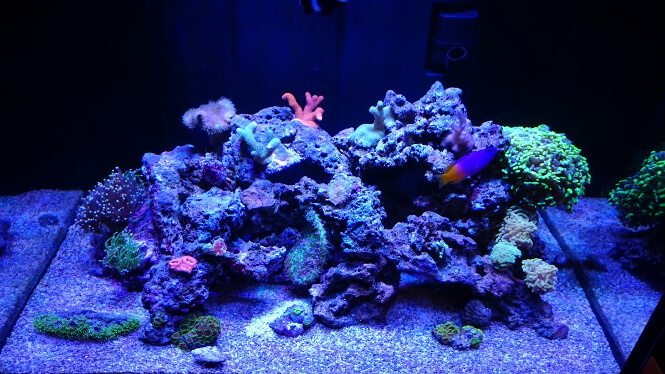
Here’s how his tank looked after 8 months of growth with the same VIPARSPECTRA:
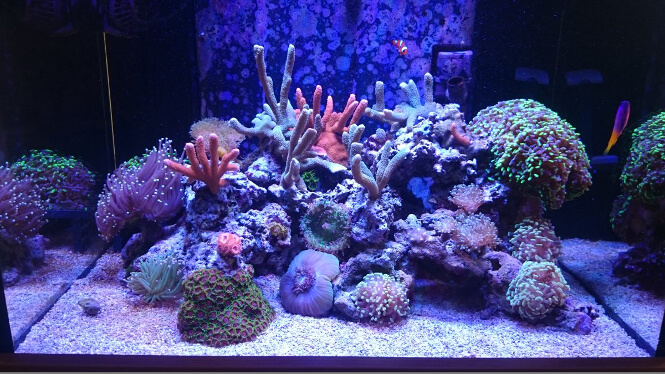
And here’s how the produced coral growth looks 16 months (less than a year and a half) after the first photo was taken:
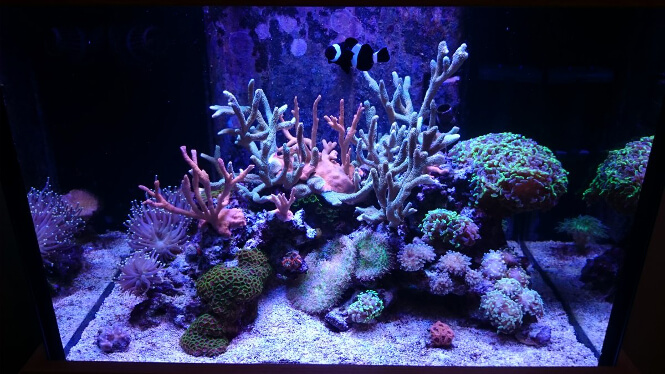
Photo collection by: Nicholas Dushynsky
Notice how well the SPS corals have developed after starting out as single small frags.
When this user started seeing the impressive growth his settings were 65% blue and 12% white.
He kept that schedule relatively unchanged as in the last photo he was running 68% blue between 2 PM and 11 PM with an addition of 25% white between 3 PM and 10 PM.
And to not say that this is a single case, here’s another photo capture of a 225 gallon aquarium that’s heavy on SPS corals, having 3x VIPARSPECTRA LED lights over it:
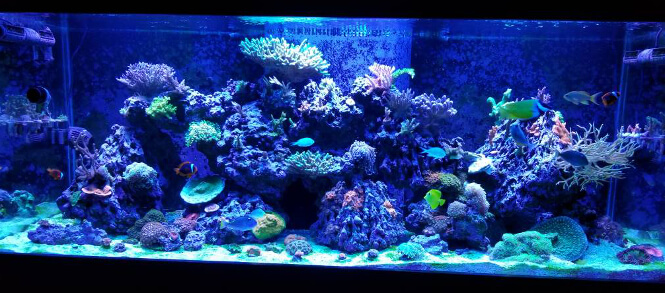
Photo by: Mrx7899
Advantages:- Fantastic value for the price tag, probably the best budget LED for deep reef aquariums
- Very budget-friendly
- Very intense and can grow virtually any SPS coral in the book (and yes, that includes Acropora)
- Has a built-in timer for 2 separate channels (blue and white)
- Has the right PUR spectrum
- Individual dimming on each lighting channel
- Wireless remote
- Solid light coverage of 24 x 24 inches
- Build allows for easy modification such as removing or changing lenses for better light spread
- Decent color blending
- No disco-ball effect on a bottom with white sand
- For longer tanks you’d need to get more than one and check on the timer synchronization every couple of months
2. Current USA Orbit Marine LED – Excellent Spectrum For Mixed Reefs
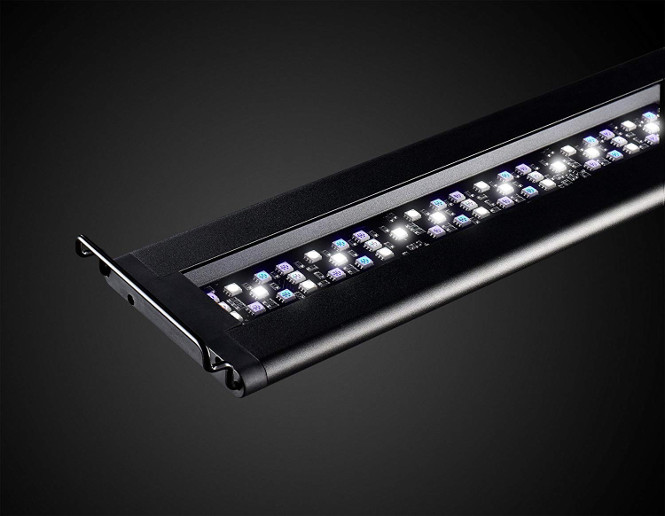
Click to compare pricing + see MORE photos of this product at:
The Current USA’s classic Orbit Marine LED lights, mostly recommended for nano reef tanks can turn you into a fan of the brand for life.
Though they’re not recognized as premium aquarium lights the Orbit Marine has been part of some gorgeous nano reef tanks that I’ve seen.
Author’s note: There is also the Orbit IC version of the Orbit Marine which essentially packs more punch. You can find the Orbit IC at both Chewy and Amazon.
The IC has dual LEDs under a single lens that’s more narrow than with the simple Orbit Marine version.
The Orbit Marine comes with a 120° lens, whereas the IC comes with 90° lenses, providing more intensity through the concentration of the beam.
Anyway, at the beginning of this review, I mentioned that you will become a fan of the brand as a whole.
That’s because with a single app you can control the LED fixtures alongside Current USA’s wavemakers and also their return pump. Click here to see the wavemaker on Amazon or here to check it out on Chewy. Both online stores also provide the return pumps.
Anyhow, the side equipment is also impeccable in quality and works like a champ, in my opinion.
The combination of these factors makes for easy overall control of your reef aquarium and you don’t have to rely on multiple devices and apps.
However, let’s talk about setups.
My experience and observations show that The Current USA Orbit Marine is ideal for shallow reef tanks that house a majority of LPS corals and a few SPS ones towards the top of the aquarium.
I’ve found that this LED light can be used with great success over LPS coral aquariums that are 15 inches deep.
It has a controllable spectrum and you can customize each of its light channels which not many of the budget reef LED lights can offer.
The spectrum itself is well-researched as Current USA seems to approach the matter seriously.
LPS corals such as the Euphyllia Hammer Coral, mushrooms, zoanthids, and low-demand SPS species such as the Monti Cap will thrive under the Current USA Orbit Marine fixture.
The shimmer is also spectacular and with the densely packed light diodes, you don’t really get a disco-ball effect on the aquarium’s bottom and interior.
The corals “pop” and become very defined, especially if you tune the white at half the intensity of the blue.
If you ramp up the blue at 100% these LED lights will easily support a 21-inch deep reef tank with a lot of LPS and a couple of SPS species near the water’s surface.
Anyhow, there’s also the Current USA Orbit Marine IC PRO Dual which is essentially a combo of 2 IC LED fixtures with 90° lensing. The Orbit Marine IC PRO Dual can support a reef aquarium that’s more SPS-heavy and has a depth of 24″.
It’s actually what the manufacturers recommend for such a setup and I find it to work as advertised.
The light spread on the width of these fixtures is roughly 24″, but half that if you want a decent growth in your SPS corals.
Anyway, the Current USA LED lights are more powerful than they seem to the human eye so make sure to use the acclimatization feature when introducing them to your aquarium.
They are one of the best LED lights you could get on a budget and as a bonus, they have tons of extra “weather patterns” simulations such as rolling clouds, thunderstorms, and whatnot.
The thunderstorm could be stressful for the more sensitive or small saltwater fish, but the passing clouds feature adds to a very realistically looking nano reef tank.
I recommend that you consider getting a standard Current USA Orbit Marine LED lighting if you aim for an LPS-dominant nano reef aquarium with a couple of SPS corals towards the top.
If you appreciate having a super cool show-off tank – this LED light and its “weather modes” are most likely the right choice for you.
Use it over aquariums with no more than 20 inches of depth and don’t ramp up the blues to 100% intensity unless you keep more SPS corals at the top.
Go with 70% intensity on the blue and 30% on the white after the acclimatization period and gradually add up the intensity while monitoring your coral (if needed).
On the other hand, if your saltwater aquarium is between 20 and 24 inches deep then go with an IC LED version.
If you plan to keep a mixed reef tank with more SPS corals then get the IC LED PRO Dual package for outstanding results and growth.
Here are two photos showing the progressive growth of LPS, mushrooms and soft corals under a single IC LED fixture, that hangs over a 10-gallon reef tank with a depth of 10 inches:

And here’s the second shot, taken 5 and a half months later:

Photo collection by: McArcher
Following is a photo capture of a 5-month growth progression in a 13.5 Nuvo tank (15.6 inches deep) with a single Current USA Orbit Marine LED:
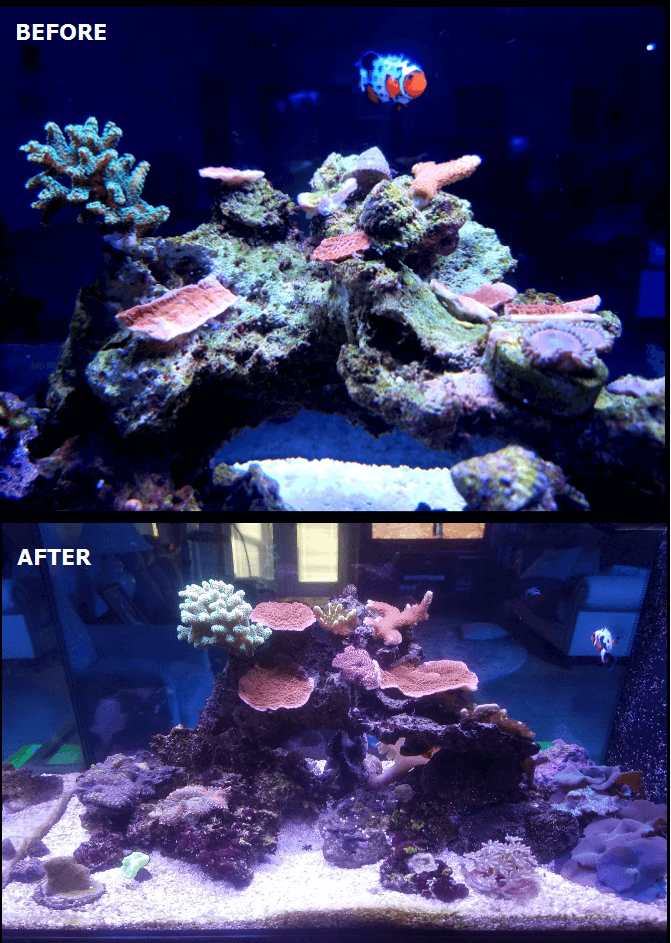
Photo by: DSC reef
And here’s how a 55-gallon aquarium with a standard size looks like after 16 months of coral growth with a single LED fixture of the 48-inch long Current USA Orbit Marine:

Photo by: zeeGGee
Advantages:- Grows blooming LPS coral colonies
- Can support Non-demanding SPS corals at the top of the tank
- Customizable spectrum
- Superb coral coloration
- Has the best shimmer from the budget LED lights listed here
- A ton of cool lighting effects
- Has a coral acclimatization feature
- Comes with remote control and a timer
- Dimmable
- Can only be used over tanks with a shallow to medium depth (only the IC LED PRO Dual can adequately be used on a tank that is 21 to 24″ deep)
- Can get rusty with time, if not installed over a glass top
3. ABI Tuna Blue – Best Budget LED for Nano & Pico Reef Tanks
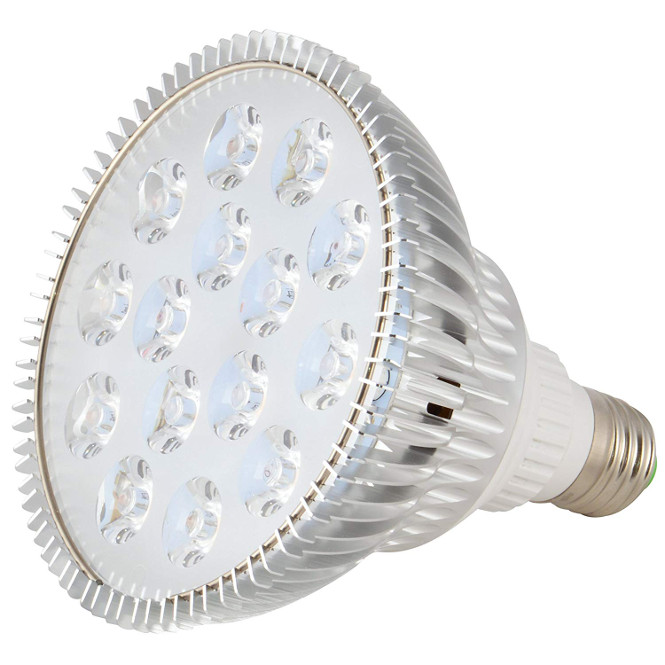
Click here to see the current price + more photos on Amazon.
If you’re on a budget, but you want to get the best LED lighting for a thriving nano or pico reef with some SPS corals, then the ABI Tuna Blue is the right option for you.
This LED light is a PAR38 bulb which means that it uses Parabolic Aluminized Reflector technology.
The ABI Tuna Blue comes in two versions – with 12 and 23 Watts of power.
The 12 W version has a 30-degree angle lens (very concentrated beam) whereas the 23 W one has 60-degree angle lensing (still concentrated but more spread).
Because of the narrow lensing and the PAR38 technology, the ABI Tuna Blue produces a very strong beam of light overall.
This allows for the LED light bulb to be used over pico or nano aquariums that are at least 12″ deep.
The spectrum leans on the blue side, though in pictures, it looks much bluer than it actually is to the human eye.
All of this makes sense because this LED lamp was designed to photosynthetically nourish corals and stimulate their growth.
I’ve seen the ABI Tuna Blue over saltwater tanks where the SPS corals absolutely thrived.
And that’s not just Montipora but also Acropora which, although more demanding, still appeared very healthy.
Anyway, use the 12 W bulb for every 10 inches of aquarium length and 12 inches of depth.
Position this LED light around 8 to 9 inches off the water surface of your nano reef. This distance should be more than enough to grow demanding corals at the top and even middle of a pico tank.
The ABI Tuna lights are bright and they’re designed to shine over a small area, so if you’d want to use them over a longer aquarium, you’d need to buy more than one.
Use the 23-Watt Tuna Blue LED over saltwater tanks that are around 16 inches deep and don’t compromise with the mounting height.
Speaking of intensity, the only way to control it along with light spread is by how far off the aquarium’s water surface you mount your PAR38 LED lighting.
Though the PUR of these LED lights is spot on, the right PAR can be tricky to figure out, but if you follow my advice from above you should be fine.
These LED bulbs do get warm to the touch (not hot) and should not ever be covered while working over the aquarium.
The build of the fixture is designed like it is so that the internal fan ventilation remains effective.
The ABI Tuna Blue can be set on a timer, which will turn it on and off, without a gradual ramp up or fade out.
Overall it’s safe to conclude that this is the best LED light for pico and nano aquariums with reef corals on a budget.
Here’s a photo shot of a 5-gallon aquarium with a depth of 11 inches and a width of 13 inches, that grows zoas, SPS and LPS corals under two ABI Tuna Blue LED lights:
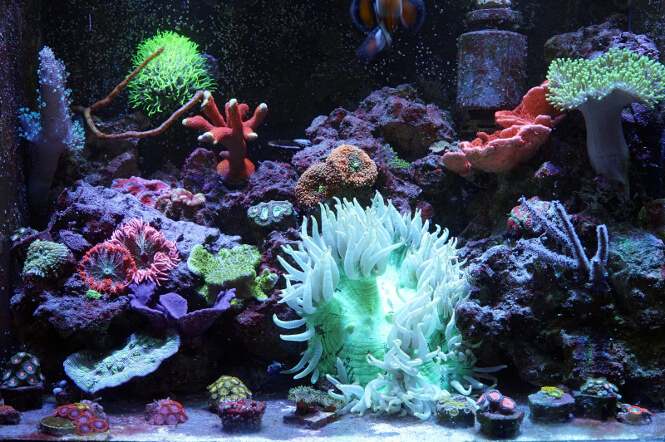
Photo by: DarkMagic
And here’s a capture of the legendary Maritza the Vase Reef that’s 10 inches high and 10 inches in its widest, while housing SPS and LPS alike under a single ABI Tuna Blue 12 Watt LED lighting (12″ off the water surface):
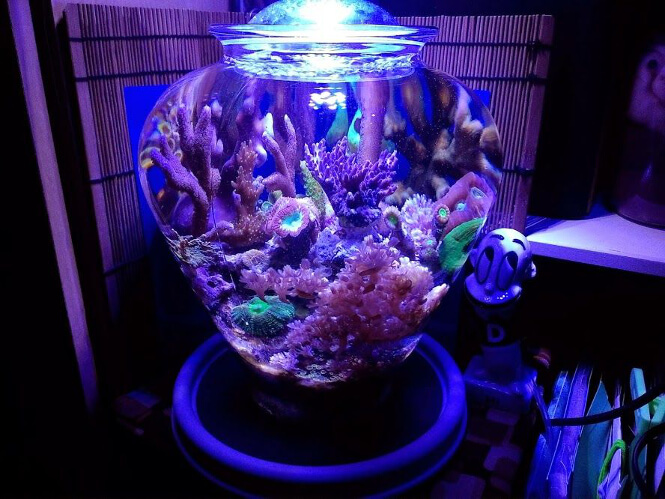
Photo by: Mary Arroyo
Advantages:- Very good bang for the buck
- Narrow lensing which allows for deep water penetration (30 and 60-degree lensing on the 12W and 23W bulbs respectively)
- Grows demanding SPS and LPS corals alike
- Durable, despite being cheaper than other LED lighting options for small aquariums
- Makes fluorescent corals “pop” nicely
- Can be set on a timer
- Top choice if you want your pico saltwater tanks to have a professional look to it
- Is not dimmable
- The light spread can only be controlled by the mounting height
- Because of the narrow lensing, you need more than one for wider tanks (anything above 12″ in length)
- Leans on the blue side, which may be irritating for some (others prefer it this way, because of the “pop”)
- It’s rather heavy, so it needs a well-built lamp gooseneck
Top 8 High-End LED Lights for Your Reef Tank
| LED Lights: | For Aquarium Depth: | Grows: | Price Bracket: |
|---|---|---|---|
| 4. Kessil A80 Tuna Blue | nano saltwater aquariums with 8 to 12 inches of depth tanks | Mixed reef tanks with SPS corals towards the top | $$ |
| 5. AI Prime 16HD Reef | 8 to 16-inch deep reef tanks | Mixed reef aquariums with an abundance of SPS corals | $$ |
| 6. AquaIllumination Hydra HD | tanks with a depth of 21 to 30 or more inches | Demanding SPS coral reef aquariums | $$$$$ |
| 7. Kessil A160WE | up to 24-inch deep tanks | Mixed reef aquariums that could be both SPS or LPS-dominant (classic setups) | $$$$ |
| 8. Kessil A360X | Optimally, 24 to 28-inch deep tanks | Classic mixed reef tanks that could be both SPS or LPS-dominant | $$$$$ |
| 9. Kessil A500X | 25 to 30 inches of tank depth | Geared towards SPS corals and will grow virtually anything | $$$$$$ |
| 10. Radion XR15/30 PRO | Tanks with a depth of at least 21 inches | High-light SPS corals | $$$$$$$$ |
| 11. Kessil AP9X | 21-inch or deeper reef tanks | Mixed Reef Tanks with Demanding SPS Corals | $$$$$$$$ |
Though reef LED lights on a budget will work (as you’ve seen from the photos above), there are also the ones that may be more suitable for your needs if money is not a factor.
The LED fixtures listed below come with enhanced controllability, a natural shimmer, customization, and durability.
If you’re the kind of reef keeper who values added quality over price then this section may be for you.
Take a look at the best high-end LED lights for a coral reef tank:
4. Kessil A80 – Best for Natural Shimmer in Nano SPS-Dominant Tanks
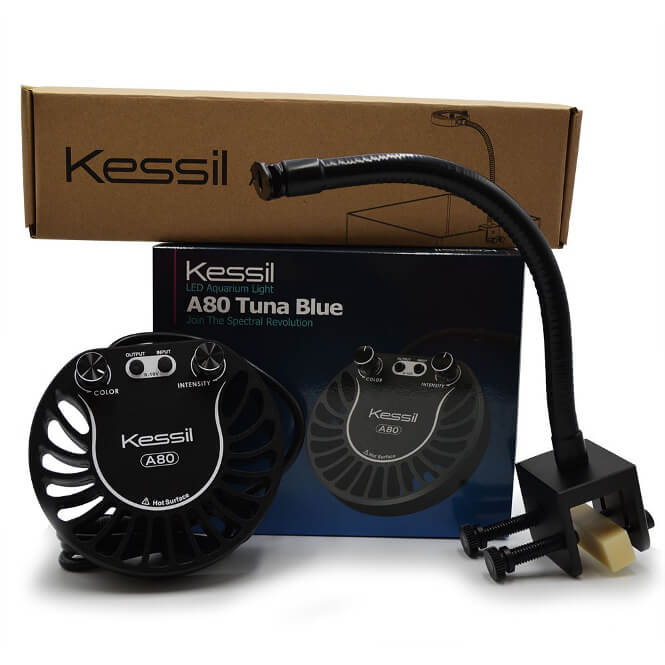
Click here to see the current price + more photos on Amazon.
The Kessil A80 is a fantastic high-end LED light for a 5-gallon reef tank with a depth of up to 12 inches.
When I first encountered this unit, I was kind of surprised that it only consumes 15 Watts of power.
However, this makes the presence of cooling fans unnecessary.
In my opinion that’s more than welcome, because I can totally eliminate any buzzing noises from the equation.
The sleek build comes with 2 manual adjusters – one for color and one for intensity.
Though I’m listing it in my “financially liberated” section I think it’s important to note that if you want more controllability you do have to buy Kessil’s spectral controller on the side. Here’s a link to the stuff on Amazon.
Aside from that, the A80 grows hard SPS corals without hesitation, as long as the other parameters such as flow and coral food are in the norm.
To grow SPS corals you should run your Kessil A80 at 40 to 50% “Color” and 80% “Intensity” in its peak time, which should be roughly 4 hours of the daily photoperiod.
For LPS corals and softies, you should probably tune the Kessil A80 down to 50% or so of intensity, while keeping the “Color”.
This LED light gives a blue-ish hue to the aquarium, which in turn makes the corals pop out nicely.
It produces the same high quality of natural shimmering as the other, more expensive Kessil models.
The water shimmer, along with Kessil’s ability to grow coral, might be the second most valued advantage of the brand.
The LED fixture itself looks futuristic, and in my opinion, it actually adds up to the external aesthetics of a reef tank.
Note that in a standard 5-gallon tank that’s 16″ in length you might get shadowing in the corners.
This LED light works best for cube-type tanks with dimensions of 12″ width and 12″ length.
If you have a wider aquarium, I suggest getting two Kessil A80 fixtures to cover all of the edges with light.
I can recommend buying the Kessil A80 if you’d like to enjoy ocean-like shimmering in your 5 or 5.5-gallon nano reef tank. This light grows mixed SPS and LPS corals, at a depth of no more than 12 inches deep.
Here are some shots of a 5.5-gallon saltwater aquarium that has mainly SPS corals grown by a Kessil A80 (4 inches from the water surface):


Photo collection by: Hirsh
Advantages:- Fantastic shimmering effects
- Very low power consumption
- Grows SPS coral very well in shallow tanks
- Virtually silent
- Futuristic design
- You need to get the branded spectral controller separately
5. AI Prime 16HD Reef – Top performer for nano cube tanks

Click here to see the current price + more photos on Amazon.
The AI Prime 16HD Reef is an LED aquarium grow light that simply has tremendous potential for tanks with corals.
Users on the more popular reef tank forums praise it and so do a couple of my buddies in our local community who happen to own it.
Multiple positive feedback aside, the AI Prime 16HD Reef has 16 high-quality diodes stuck under a single diffuse lens.
This helps for better shimmer, superb color blending, and (my favorite) evening out the output intensity.
This combined with a more expensive set of diode emitters gives the reef aquarium an even light coverage and the possibility to own SPS corals.
Speaking of light spread, one thing that’s worth mentioning is that this unit only provides good coverage for about 15″.
You’ll have extremely good results with more demanding corals if you mount it over a 12″-high x 12″-long cube tank.
For anything that’s more than 12″ inches in length which may have SPS corals in it, you should get a second AI Prime 16HD Reef.
You can still mount it over an aquarium that’s 20″ in length, but then you should probably keep less demanding LPS corals and softies in the corners.
Anyhow, this reef LED light is not at all heavy, it’s got a modern design and also is very, very quiet when running.
I think having a silent lighting fixture removes the pressure from having to place your new aquarium in rooms that people don’t sleep in.
The last but not least advantage of the AI Prime 16HD Reef is the built-in controller that comes with a native app.
Connectivity is huge with this product, as you can tweak it from the comfort of your couch, which makes things way easier.
You also have control over 8 channels of the light spectrum and the overall intensity.
Anyway, you should buy the AI Prime 16HD Reef if you have a tank that’s 12 to 15 inches deep. At this tank depth, you should be able to grow any LPS or SPS corals.
If you value decent controllability and the possibility to operate the unit from a distance then this LED light is for your saltwater tank.
Anyhow, let me show you some examples of how well this light grows corals.
The reef tank in the photo below has a depth of 21 inches. Here’s how a month and a half of coral growth looks like under three AI Prime 16HD Reef lights:
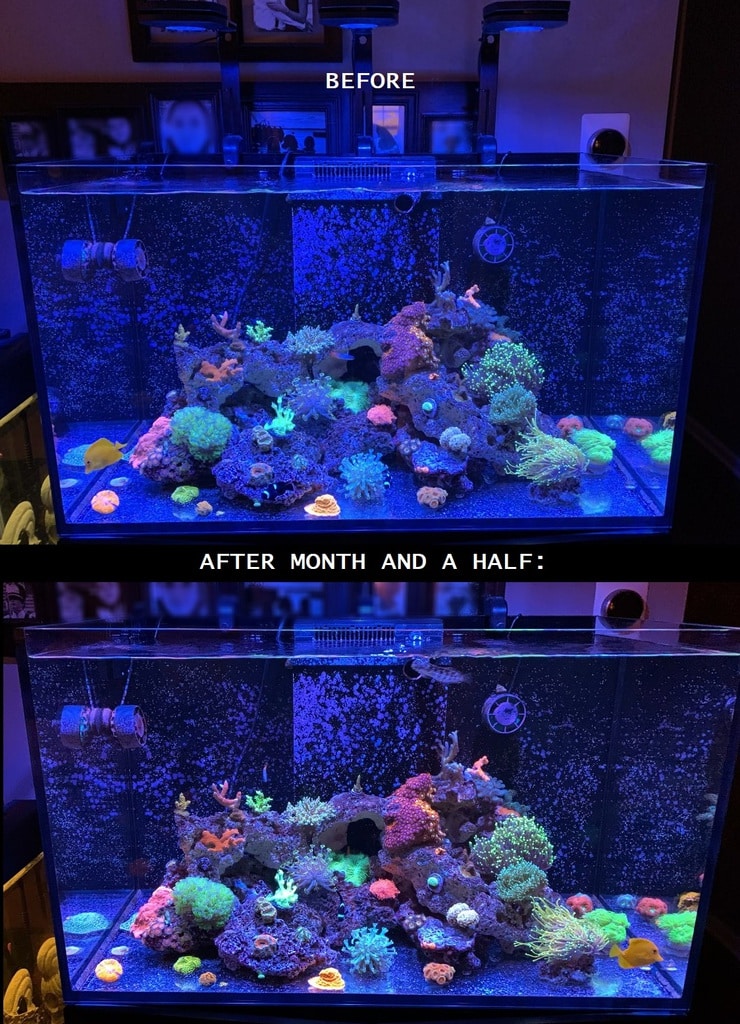
Photo by: Waynerock
And here’s a 13-inch deep, saltwater fish tank that has 2 x AI Prime LED fixtures while housing multiple varieties of LPS corals and a couple of SPS ones towards the top:

Photo by: footgal
Advantages:- Connectivity
- Excellent controllability and customization
- Bright and it will grow demanding corals in shallow to medium depth saltwater tanks
- Quiet fans
- A built-in controller that doesn’t require buying an extra module
- Native app
- Built-in diffuser
- Great customer support
- The shimmer is good but not natural-looking
- The remote connection is Bluetooth only
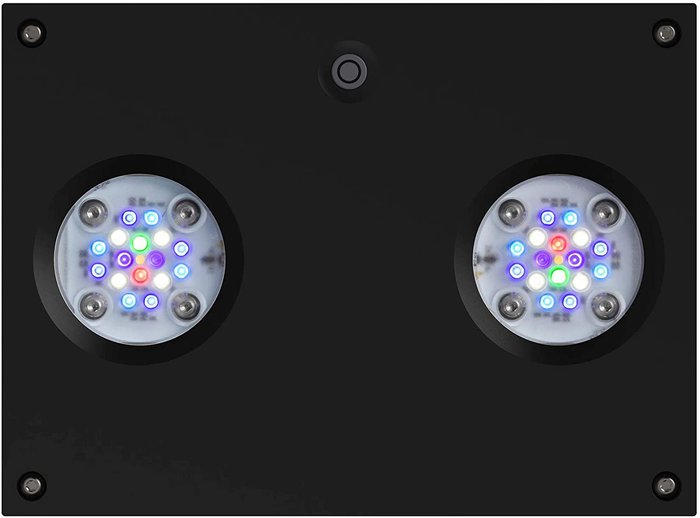
Click below to see the current price + more photos of these products on Amazon:
The AI Hydra series are the tough cousins of the AI Prime 16HD Reef LED and I’ve been very happy with their performance.
The AquaIllumination ThirtyTwo HD has 32 high-quality diodes packed in 2 nests, whereas the SixtyFour has 64 diodes that come in 4 groups of 16.
These LED fixtures are among my favorites as high-end lighting for saltwater aquariums with corals.
Both the Hydra 32 and the 64 version provide a super even spread of light and intensity.
The shimmer on the tank’s bottom is not top-notch as with a Kessil, but it’s still visually appealing and pretty.
The built-in controller and the app are huge on their own as these lights provide the best customization in the hobby, in my opinion.
The Hydra HD is a very well-thought, all-in-one solution for every reefer who would like to have full hands-on control over their marine tank.
The effective coverage of each Hydra 32 HD is close to 20 inches of aquarium length. The coverage is more narrow because these fixtures have a concentrated lens of 80° that allows for deeper water penetration.
You can easily cover a saltwater tank with 48″ of length with two AI Hydra 32 HD LED fixtures.
Some users prefer to cover the same aquarium length with three 32s for maximum efficiency and coverage. In the latter case, the reef tank is very heavy on coral.
Anyway, I’ve run the numbers and in most cases, where you don’t own a super deep tank of 28″ with high-light demanding SPS corals, the AI Hydra 32 HD wins over the 64 series.
In fact, these fixtures will be more than enough to grow demanding coral at anything in the range of 18″ to 24″ of depth. Also, having multiple 32s provides more light coverage than a single 64.
Position the fixtures at around 10 or 12 inches off the water surface and ramp up the intensity to around 70%. Don’t go up to 100% as these LED lights are strong.
Anyway, this way you’ll have an even enough spread to grow SPS corals with LPS and other low-light ones in the corners where the beam fades.
Another thing that you’re buying with the AI Hydra reef lights, is multiple pre-set modes that actually work as advertised.
I find the Acclimatization feature extremely helpful.
It helps new corals immensely in avoiding lighting stress and getting bleached after being introduced to the saltwater tank.
I’d purchase an AI Hydra 32 HD if I had an aquarium with medium depth (18 to 25 inches) that has mainly SPS corals in it. Also, I’d get this product if I wanted to have extensive control over everything that’s going on with my tank’s LED lighting.
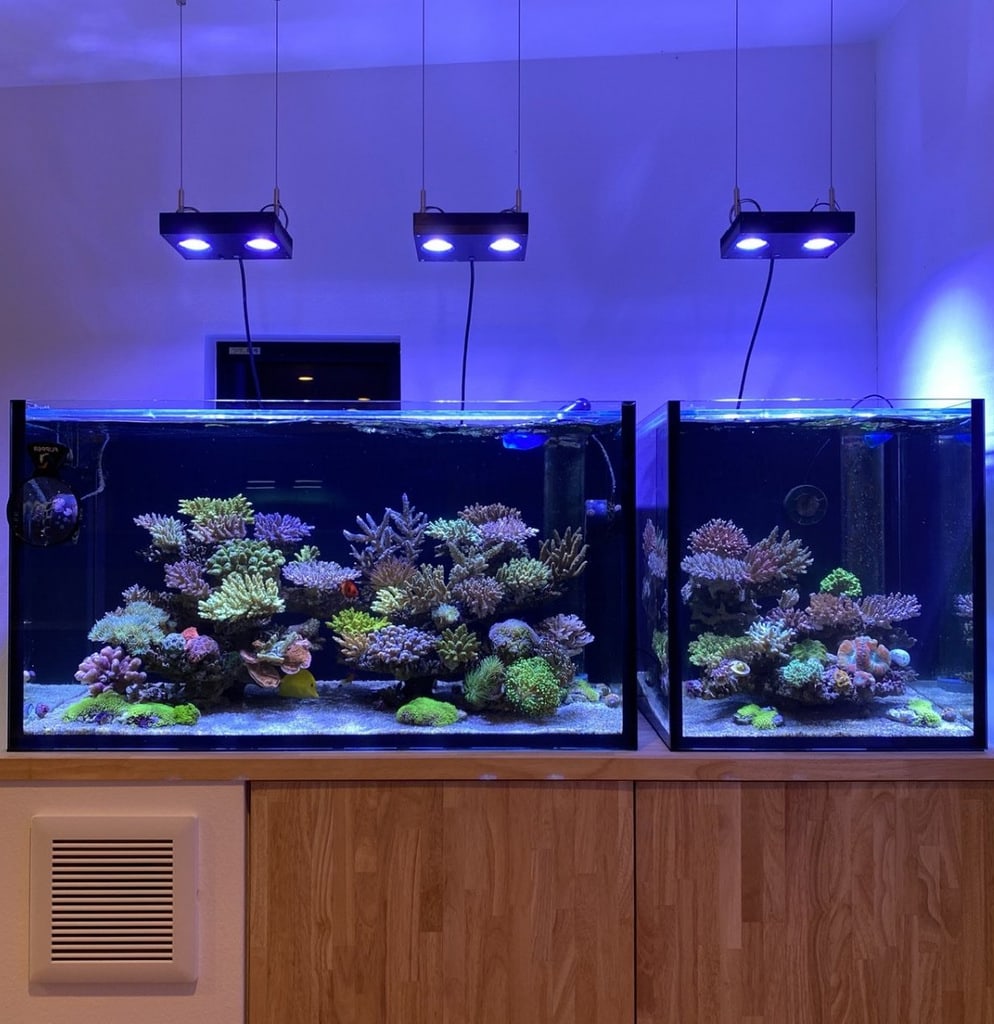
Take a look at how these SPS-dominant, coral reef tanks thrive under 3 fixtures of the AI Hydra 32 HD:
Photo by: Takaki1980
And here you can see a 120-gallon aquarium that has won an Acropora (SPS coral) grow-out contest, running five of the older Hydra 26 HD LED lights:
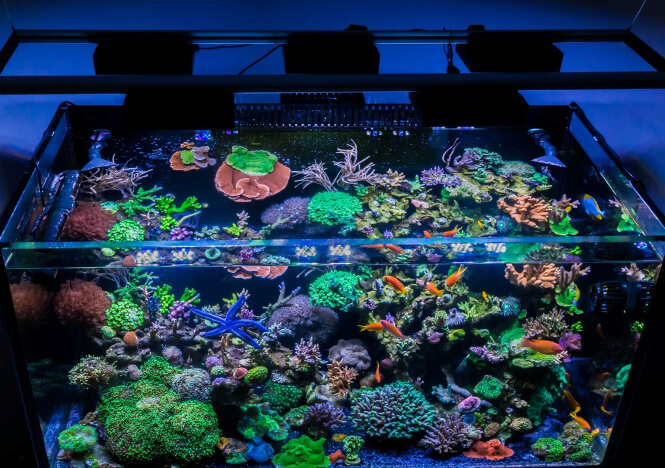
Photo by: hart24601
The user has probably used so many LED fixtures because the 120-gallon tank has a width of almost 25 inches and a length of 48 inches.
In that case, the user likely wanted to provide illumination from every possible angle and eliminate any internal shadowing.
Advantages:- Connectivity with a built-in controller
- Almost unlimited customization
- Hands-on controllability over each aspect of the lights
- Grows demanding SPS corals such as Acropora species
- Silent ventilation systems
- Native app
- Built-in diffuser
- Excellent customer support
- Very even intensity (PAR) distribution across the aquarium
- Setting it up can be time-consuming because of all the customization but YouTube is your friend
- The shimmer looks pretty, but you can’t compare it to a Kessil
- Remote connection is Bluetooth only (no WiFi)
7. Kessil A160WE – Undisputed Shimmer & Pre-set settings that work

Click here to see the current price + more photos on Amazon.
Kessil has almost dominated the aquarium industry with its LED lighting and is a preferred choice by many reefers.
There are 3 upper-class Kessil LED lights that have proved great results when ued for coral growth:
- Kessil A160WE Tuna Blue;
- Kessil A360X Tuna Blue;
- Kessil A500X Tuna Blue – this one got released in 2021.
I’ve included links to their most reputable sellers on Amazon as they usually have the best prices online. Visit each link to check their price and some more user reviews.
Author’s note: Kessil has discontinued the A360WE which was the predecessor of the A360X. Both beasts, but the A360X leads with a small margin in light spread and looks better. The A360X also had less PAR which, however, could literally be tripled with their Narrow Reflector. If you’re interested – here’s someone who tested the PAR results of the A360X with the narrow reflector and confirmed this.
Anyway, as with every Kessil fixture on this list you’ll have unmatched color blending and a fantastic shimmer galore that will make your reef tank look natural.
This is my opinion and it appears that many experienced reef coral keepers agree.
So how about intensity and coverage with the A160WE LED spot light?
I’ve personally seen tremendous growth in SPS corals with a couple of A160WE Tuna Blue fixtures. Each of these aquariums was between 20 and 24 inches in height.
Anyway, each Kessil A160WE covers about 15 inches in diameter effectively (in regards to SPS growth support) if positioned perpendicular to the water surface.
Author’s note: When eyeballing one of these models you should know that this brand conducts its own scientific research and, based on that, they pre-program the light settings.
This is what’s called Kessil Logic. Kessil Logic is basically locking up the viable wavelengths that support coral growth the best, while only letting users tune the rest according to their visual preference.
I think this is part of what you pay for in Kessil’s LED reef lights, as they are more of a “set it and forget it” product.
In fact, I wouldn’t recommend that you buy a more customizable fixture if you won’t be able to resist the urge to tinker with spectral quality once you’ve set your mind on the initial settings.
A spectrum that’s often changed will result in poor coral health and high mortalities.
The guys from Kessil know that, so they made it easier for everyone involved by just locking out the shorter wavelengths with their data-tested results and calling it “Kessil Logic”.
For this reason, I think that the Kessil Logic technology suits beginner reefers ideally.
You can safely set the lighting schedule to 50% or 60% “color” and start with a 30% “intensity” at the peak of the photoperiod.
You can slowly increase the intensity by around 5% every week and a half and see how your corals react.
Going over 50% intensity with a Kessil is a sure way to bleach or significantly slow down your corals.
Author’s note: A couple of other experienced reefers and I think that this is the secret behind the initial success of T5s and Metal Halides – not having the opportunity to tinker with the spectrum while letting your corals adjust and simply grow.
Anyway, as you may have guessed, the Kessil LED lights are extremely good at growing any kind of coral, zoa, mushroom, and anemone.
Some users online do report a slow growth, but in my experience, this is likely attributed to user error.
Some of the people with the prettiest reef aquariums that I know grow their corals under (primarily) Kessil LED lighting. I also don’t know persons who are knowledgeable and haven’t grown their corals with Kessil.
SPS corals thrive like there’s no tomorrow and there’s an overall “pop” and shimmer that realistically rivals what you see when you do reef diving.
You should probably buy your corals a Kessil LED light if you have a reef tank that’s 20 to 30 inches deep and you want top-of-the-industry internal aesthetics.
As for the A160WE model: Go for the A160WE Tuna Blue and spread one unit per 15 to 16 inches of aquarium length and width if you have an SPS-dominated saltwater tank that’s around 15 inches deep.
Anyhow, here’s how the growth in a 48″-long, reef aquarium with a lot of SPS and LPS corals looks like under three of the old Kessil A360WE LED lights:

Photo by: Eckolancer
And here’s a photo of how a 47.5-inch long 92-gallon reef tank looks like under 5 fixtures of Kessil A160WE Tuna Blue:
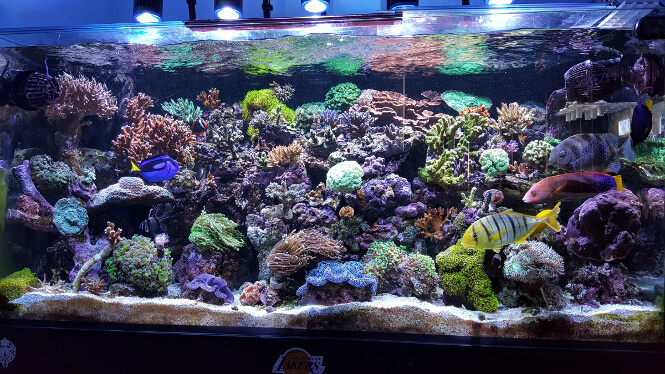
Photo by: HB AL
Advantages:- Stupendous durability
- A rather “set it and forget it” solution
- Fantastic realistic shimmer
- Undisputed color blending
- Silent ventilation, yet the fixtures don’t ever get hot, just warm
- Kessil Logic feature which ensures that the vital for coral growth wavelengths are in the right spectral proportion (great if you’re a beginner)
- Grows corals and anemones that demand high light
- Stylish build
- Top-notch customer support
- One of the best money value per diode from the premium bracket
- The manufacturers have over 20 years of experience in the LED lighting industry, thus conducting their own scientific research on which they base their products
- If you want extra controllability you should buy the spectral controller separately
- You need to buy the mount separately
8. Kessil A360X Tuna Blue

Click here to see the current price + more photos on Amazon.
The following review is an addition to what I said about Kessil LED lights in the section about the A160WE model. I strongly suggest that you read the that section first and then continue here.
A Kessil A360X without any narrowing lenses will grow demanding corals in in a circle of about 18 inches in diameter.
Simply put, the A360Xs are twice as powerful as the A160WE but pretty much have the same cone of light spread, although penetrating water way deeper.
To be honest, I wouldn’t get a Kessil A360X unless my saltwater tank is more than 25″ deep. Some users have theme on their 20 inch-deep aquariums and so can you if you plan to gradually move to an SPS-dominant coral setup.
One thing about the A360X coral grow light (and the A500X for that matter) that many reef keepers consider great is its “new” spectrum channels you gain control over unlike with older models.
See, if you connect the A360X or A500X to the Spectral Controller or the Wi-Fi Dongle you get to play with adjusting the violet and green spectrums too!
I also like that.
One of the strongest selling points of Kessil is the Kessil logic.
Kessil has the blue spectrum in their newer LED lights locked, which is great for coral growth in general, and have unlocked the violet and green one in the A360X and upper models.
The green is somewhat “meh” for aesthetics but the violet is crushing it!
Ramping up the violet channel to between 60 and 80%, and the Color setting to about 30% makes my corals pop like never before.
I won’t lie, I enjoy it a lot.
Here’s a beautiful SPS coral grown with only Kessil A360X lights and nothing else:

Photo by: Teddy00024
- Everything from the section about the A160WE above
- Has unlocked the Violet spectrum which can absolutely make your corals pop (needs the WiFi Dongle or the Spectral Controller)
- Is extra flexible with the intensity because of the narrowing reflectors (roughly 3x the PAR if you ever need that)
- Everything from the section about the A160WE above
- Even the narrowing reflectors need to be bought separately :’)
9. Kessil A500X Tuna Blue – Power, Growth, Aesthetics
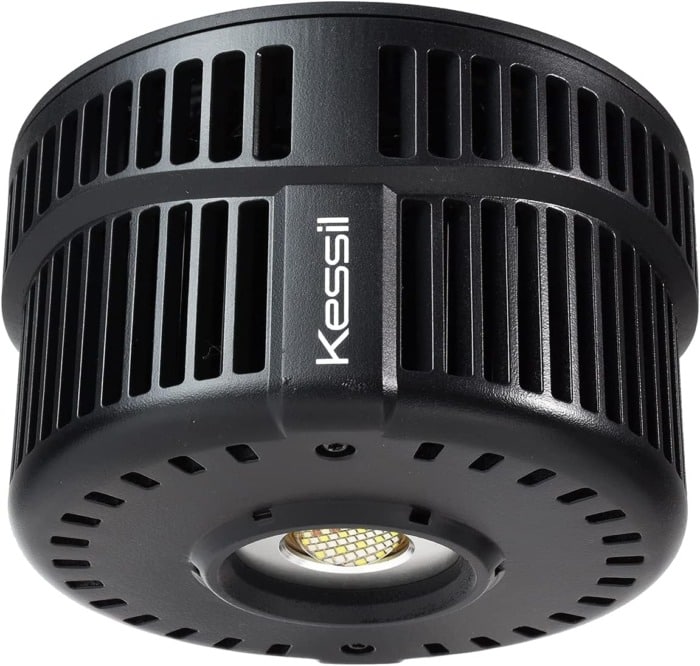
This review is a follow-up to what I’ve said about the Kessil brand in the review section about the A160WE model. Read that one first if you haven’t and then scroll back down to read here.
Ok, so not much has changed within the LED aquarium lighting industry since I last updated this article.
I’m assuming that’s because it’s already difficult to achieve noticeable progress in this type of technology.
One thing that changed however, is that Kessil’s A500X spot light is now somewhat well-tested among users.
Back in 2021 when I thoroughly revised this article and almost completely re-wrote it, the A500X was just released.
I could buy and test it for the sake of including it here, but that would’ve been too much of an anecdotal experience.
Nowadays there’s more data and reports from people using it, which makes whatever findings I have about it – somewhat confirmable.
So what’s new with the Kessil A500X light and why am I talking about it in my “best of” list? Not much, except that it’s basically twice as powerful as the A360X, with the latter packing a decent punch on its own.
The Kessil A500X LED light has twice the wattage and twice the number of diodes of the A360X.
On top of that, you can use the narrowing reflector to multiply the intensity but, to be honest, I don’t recommend that with such a powerful spot light.
All of this results in the A500X being an amazing grow light for a deep, square-shaped reef tank with SPS corals.
What I like about this kind of raw power in an LED light is that I could hang it higher above my tank, which makes for a more stylish overall outlook of the system.
Get the Kessil A500X if you have a 24+ inches deep tank and want to be able to look after SPS corals either right away or in the future.
These stylish LED spot lights are great for any display tank that puts an emphasis on natural shimmer and overall flashy aesthetics.
Kessil’s aquarium lights never disappoint when it comes to visuals.
Here’s a 6-foot reef tank that’s 24 inches deep having its SPS corals grow like mad with only three Kessil A500X LED lights:
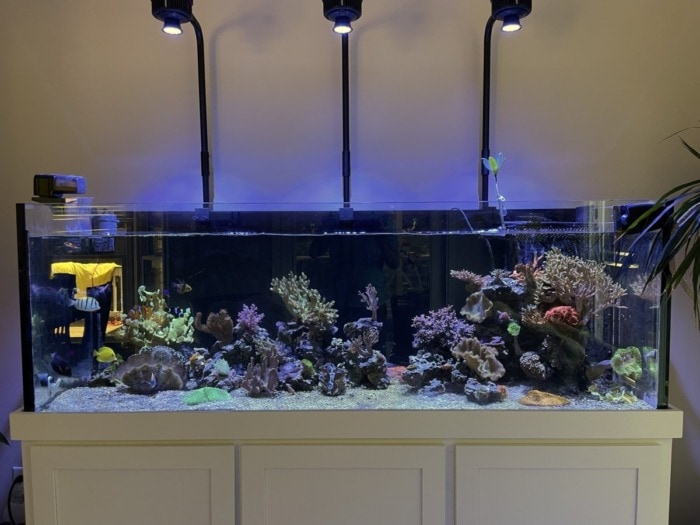
Photo by: Mark
Here’s what a couple of Kessil A500X look like over another tank with some thriving small polyp stony corals:
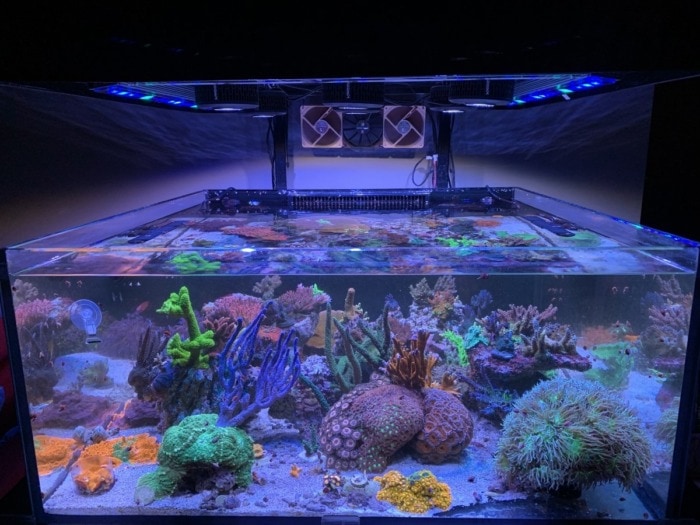
Photo by: minus9
- Everything from the section about the A160WE above
- Is the most power powerful Kessil LED spot light to date
- Has unlocked the Violet spectrum which makes corals pop fantastically (needs the WiFi Dongle or the Spectral Controller)
- Is extra flexible with the intensity because of the narrowing reflectors which can triple the PAR if needed
- Everything from the section about the A160WE above
- Even the narrowing reflectors need to be bought separately :’)
10. Ecotech Marine Radion LED XR15/30 PRO G6 – Most powerful & No shadowing

Click here to see the current price + more photos on Amazon.
What I like about the Radion XR Series is that these LED lights have the potential to provide the best coverage in combination with what’s probably the most powerful output.
Both aspects are important for a deep reef tank with SPS corals, which also has a considerable width.
Some PAR readings online claim that the Radion XR Series has the strongest intensity among all other LED reef lighting products in the high-end bracket.
These lights will grow SPS corals and by having a Radion you can pull off an aquarium that is dominated by the species that have the highest demand for lighting.
The older, GEN5, Radion lights already had a shimmer and color mixing that looked very natural. For the sake of comparison, a Kessil LED light would still produce the best shimmer on the market.
The difference between EcoteTech Marine’s Radion XR GEN6 Series and the GEN5 series i that the G6 has a little bit more light spread, draws a little bit more power, and brings out some extra fluorescence in your corals.
One thing I find to be super impressive with the G6 is that there were virtually no hot spots when I took some PAR measurements. This is an amazingly designed LED lighting system in that regard.
Author’s note: If we’re speaking strictly PAR, the G6 seems like it has lost some to the G5… However, what seemed “lost” is now better spread across the whole illumination area. A better spread and evenly distributed light is what you’d want when trying to growing corals in larger reef tanks. Having said that the G6 is still objectively a beast among beasts when comparing its PAR readings to other brands of LED aquarium lighting.
Speaking of comparisons: The GEN6 Radion XR15 / XR30 LED lights come in two distinctive versions:
- Radion XR15/30 G6 “PRO”
- Radion XR15/30 G6 “BLUE”
The GEN6 BLUE Radion has more blue diodes, whereas the GEN6 PRO Radion has more white diodes. Corals are extremely adaptive to these spectrums and therefore both GEN6 LED fixtures will produce growth. The only noticeable difference between the two GEN6 Radion LED lights is the look of your reef tank. The GEN6 BLUE will make the tank look more on the blue side and fluorescent corals will pop out more. The GEN6 PRO will make the aquarium look more natural in color as if you’re reef diving, but you’ll still get a decent fluorescence.
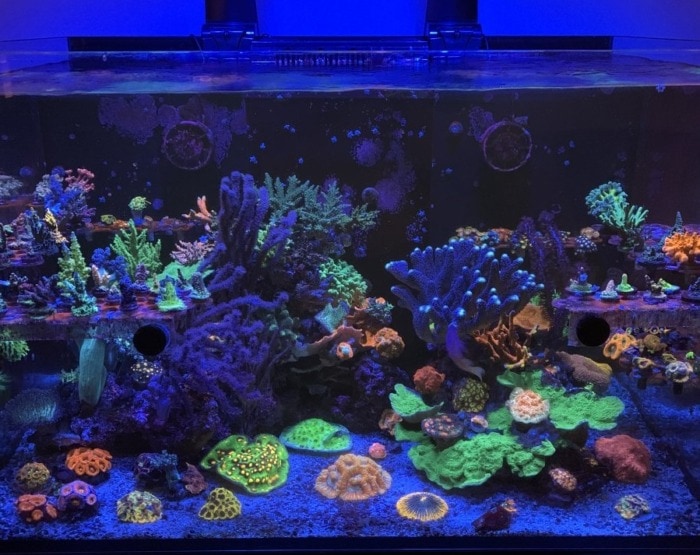
Photo by: HudsonReefer2.0
I personally prefer the PRO version. The corals still have great color and the growth is there.
Anyway, the new GEN6 Radion LED lights only work with EcoTech’s Mobius app. The app has pre-set templates for coral growth, including one specially designed for SPS corals, called “SPS AB+”.
From what I’ve seen in real life the AB+ works as advertised and really does support SPS growth as long as you nail the intensity right and avoid bleaching your reef tank.
In my observation, you should aim for around 70% intensity in the peak of the photoperiod, but that’s after full acclimatization.
Go for close to half that if you have a mixed reef tank or you’ll obliterate your corals.
Speaking of coral bleaching, one of the most valuable features of the Radion GEN6 LED lighting, in my opinion, would be the Acclimate Timer, which allows for programmatic scaling of intensity over a period of a couple of weeks.
This immensely helps with avoiding coral bleaching and photoinhibition (hindering growth caused by too much light) when introducing these very, very powerful LED lights to your reef tank.
WIth the XR15 PRO, you’ll be able to illuminate an effective coverage of almost 24″ for SPS corals, which is more than most point-lights on this premium list.
The difference between Ecotech’s XR15 PRO and XR30 PRO is literally the number of diodes, and therefore the available spread and intensity.
Though the Radion XR30 PRO would be twice the power of an XR15 PRO, it may turn out more cost-efficient to actually run 2x XR15 PROs rather than one XR30 over a larger reef tank.
Because of how the diodes are positioned in the nests, with the XR15 PRO version you get much more spread and even reach.
Place one XR15 PRO G6 fixture per 22 inches of aquarium width and length for reef aquariums that are heavy on SPS corals.
In my opinion, it’s only worth getting the XR30 PRO G6 if the depth of your saltwater tank goes beyond 25 inches.
I recommend buying the Ecotech Marine’s Radion XR15 PRO G6 or the XR30 version if you’re budget-independent and want to run a reef tank with a lot of SPS corals and a few LPS ones.
It will likely be the right purchase for you if you want to completely eliminate the possibility of shadowing and if your tank is at least 24 inches deep and wide.
If natural shimmer is not your ultimate goal, you will enjoy this reef LED lighting the most.
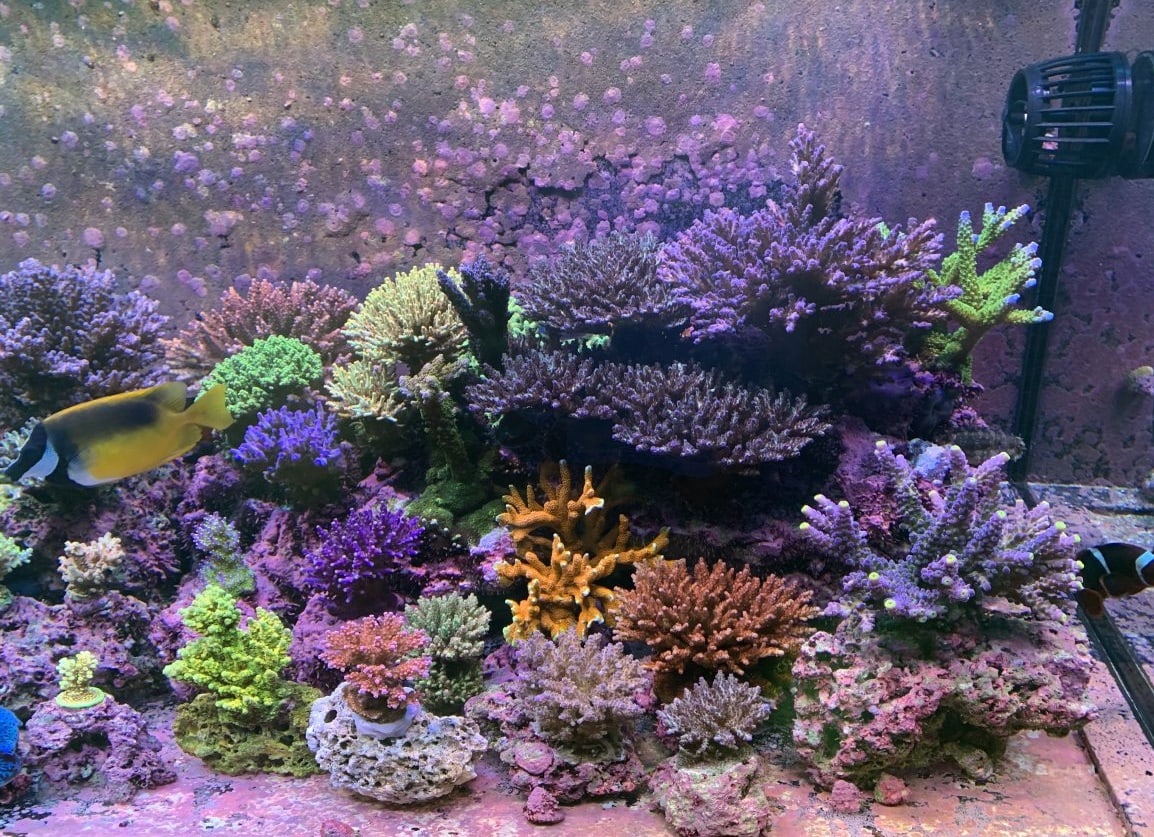
Here’s a photo of a tank with SPS corals that have been growing under 3x Radion XR30 PRO as LED lighting:
Photo by: dadnjesse
Take a look at this stunning reef aquarium that grows demanding SPS corals with the AB+ settings on three Radion XR30 PRO LED lighting fixtures:

Photo by: zoomonster
Advantages:- Probably the most powerful LED lights to grow SPS coral colonies in a reef tank at home
- Grows any corals at virtually any commercially available aquarium depth
- Undisputed coverage and lack of shadowing
- Very even light spread
- Deeply customizable
- Has scientifically tested pre-set spectral templates that grow beautiful corals
- Has the very useful Acclimate Timer feature
- Stylish design of the fixtures
- Extremely long-lasting
- Good shimmer
- Is actually expensive even by the reef keeping standards
11. Kessil AP9X – for Explosive Coral Growth
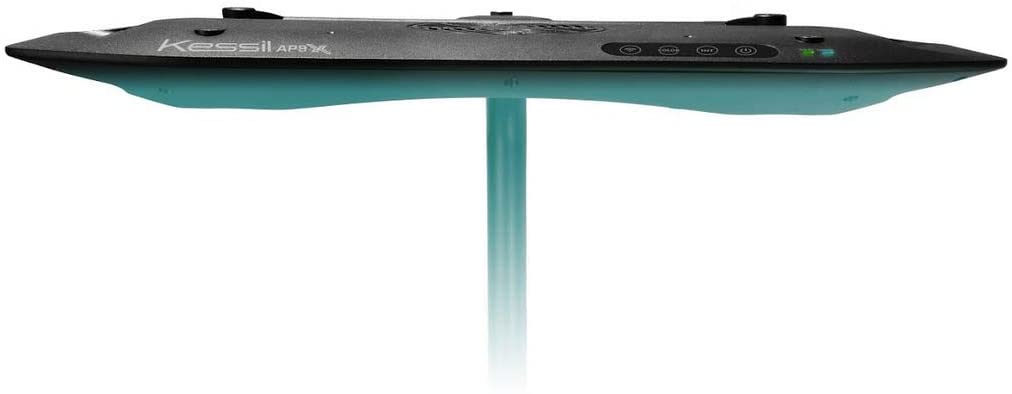
Click here to see the current price + more photos on Amazon.
I love Kessil as a brand, and I must say that the AP9X is a huge improvement from their previous attempt on LED aquarium lighting fixtures (the AP700).
The Kessil AP9X is really one of the best LED lights you could get for your reef tank and its Premium pricing does match my expectations for the value.
Anyway, as far as intensity and quality of light go, this reef lighting fixture has it all.
The Kessil AP9X has an excellent light distribution across the tank and, in my opinion, the best color blending on the market.
I’ve personally seen this LED fixture grow great Acropora corals, contrary to what the naysayers are saying.
The polyp extensions on both SPS and LPS corals immediately responded after mounting the AP9X.
There were also other corals that were struggling to color up but began showing awesome coloration just days after the AP9X was installed over the aquarium.
I’ve also found reliable reports by other experienced reef keepers confirming that the Kessil AP9X grows SPS very well.
Anyway, it can either be mounted at the suggested 7 inches off the water surface or you can go higher, and ramp up the intensity a little to compensate for the PAR while having great coverage.
All of this would be sufficient for saltwater fish tanks with no less than 24″ of depth.
The efficient light coverage spreads around 36 inches in tank length and 24 inches in tank width.
Though there are only two “pucks” (nests) of LE Diodes the coverage is more than enough for mixed-reef tanks with 3 feet of length.
Each LED nest is densely packed with over 50 high-quality diodes. There are around 9 inches between the LED pucks which do reduce the PAR between them by a small fraction. However, I’ve found that in the grand scheme of things this will not really affect the coral growth in a beautiful reef tank.
Proper coral positioning should still be taken under consideration to avoid larger species casting shadows over the ones beneath.
Always use the acclimatization feature when switching to this LED light or you’ll lose some color and cause stress, because of how intense the output is.
The spectrum has the wavelengths that are vital for coral growth locked under the Kessil Logic technology and you’re left to play with the White Channel and Intensity only.
The AP9X is a full-spectrum reef LED light, which provides enough of each wavelength for the best coloration and growth of healthy corals.
The fixture itself is very light and only weighs around 2 pounds. The fans are super silent and at times you’ll be wondering if they’re even working because of how quiet they are.
The design of the Kessil AP9X LED is sleek, one of the best ones I’ve seen in any reef lights.
Anyhow for a LED light in this class, there are some things I did not like.
For example, the people from Kessil did not include a mounting kit for the price point.
Another thing that may slightly irritate you at first is that connecting to the Internet can be hard.
If you’re experiencing connectivity issues, you can do a “hard reset” by pressing and holding the WiFi and the INT button simultaneously for at least 3 seconds.
I, personally, did find the app user-friendly, and the fact that it allows having multiple Kessil fixtures together was an improvement from the previous AP700 model.
Effectively connecting a single group of Kessil reef lights is pretty easy and intuitive.
Anyway, my final evaluation is that the hardware of the Kessil AP9X LED lighting is outstanding and the software does its job. Get this light if you want to grow stunning SPS corals with some LPS and clams towards the bottom of the reef tank.
Advantages:- Supports SPS-dominant reef aquariums well
- Has great light spread
- Has the best color blending
- The typical, unique for the Kessil LED lighting, shimmer
- Beautiful exterior that adds to the overall aesthetics of the aquarium
- Covers a very wide range of spectral wavelengths
- Splendid coloration and “pop” of corals
- Has the important Acclimation lighting template
- The body of the fixture is very light
- The Kessil Logic makes sure that your corals will flourish
- Can be connected to a WiFi
- You should buy the mounting/hanging kit separately
Which LED lights should you choose according to your aquarium’s dimensions?
Since reef aquariums are often far from the standard gallon capacity and size I think that it will make more sense to base my recommendations on dimensions.
All of my advice here will also be based on real-life reports or personal experience and observations with the LED lighting fixture and the depth at which it produced the best coral growth.
I’ve discussed the motivation behind my cost-oriented unit suggestions in my general article on the best LED aquarium lighting for each gallon size, which would be relevant to you if you’re the owner of an aquarium with standard dimensions.
In that case, visit the link to quickly find a table at the beginning of the post with each possible marine setup. Look up the one that matches your saltwater tank’s gallon capacity and click on that link.
That being said, the best LED lighting for your coral reef aquarium according to the tank’s depth would be:
- 8-inch deep tank with plenty of SPS corals: Abi Tuna Blue 12W
- 8-inch deep tank with mostly LPS corals: Abi Tuna Blue 12W
- 10-inch deep tank with plenty of SPS corals: Abi Tuna Blue 12W
- 10-inch deep tank with mostly LPS corals: Abi Tuna Blue 12W
- 12-inch deep tank with plenty of SPS corals: Abi Tuna Blue 23W / Current USA Orbit Marine LED
- 12-inch deep tank with mostly LPS corals: Abi Tuna Blue 12W
- 16-inch deep tank with plenty of SPS corals: Abi Tuna Blue 23W / Current USA Orbit Marine LED
- 16-inch deep tank with mostly LPS corals: Current USA Orbit Marine LED
- 18-inch deep tank with plenty of SPS corals: VIPARSPECTRA 165W / Current USA Orbit Marine IC LED
- 18-inch deep tank with mostly LPS corals: Current USA Orbit Marine LED / VIPARSPECTRA 165W / Abi Tuna Blue 23W
- 20 to 21-inch deep tank with plenty of SPS corals: VIPARSPECTRA 165W / Current USA Orbit Marine IC LED
- 20 to 21-inch deep tank with mostly LPS corals: VIPARSPECTRA 165W / Current USA Orbit Marine LED
- 22-inch deep tank with plenty of SPS corals: VIPARSPECTRA 165W / Current USA Orbit Marine IC LED PRO Dual
- 22-inch deep tank with mostly LPS corals: VIPARSPECTRA 165W / Current USA Orbit Marine IC LED
- 24-inch deep tank with plenty of SPS corals: VIPARSPECTRA 165W / Current USA Orbit Marine IC LED PRO Dual
- 24-inch deep tank with mostly LPS corals: Current USA Orbit Marine IC LED / VIPARSPECTRA 165W
- 26-inch deep tank with plenty of SPS corals: VIPARSPECTRA 300W
- 26-inch deep tank with mostly LPS corals: VIPARSPECTRA 165W / Current USA Orbit Marine IC LED PRO Dual
- 28-inch deep tank with plenty of SPS corals: VIPARSPECTRA 300W
- 28-inch deep tank with mostly LPS corals: VIPARSPECTRA 165W
- 30-inch+ deep tank with plenty of SPS corals: VIPARSPECTRA 300W
- 30-inch+ deep tank with mostly LPS corals: VIPARSPECTRA 165W
And here are the best premium LED reef lights according to your tank’s depth in inches:
- 8-inch deep tank with plenty of SPS corals: Kessil A80 / AI Prime 16HD Reef
- 8-inch deep tank with mostly LPS corals: Kessil A80 / AI Prime 16HD Reef
- 10-inch deep tank with plenty of SPS corals: Kessil A80 / AI Prime 16HD Reef
- 10-inch deep tank with mostly LPS corals: Kessil A80 / AI Prime 16HD Reef
- 12-inch deep tank with plenty of SPS corals: AI Prime 16HD Reef / Kessil A80
- 12-inch deep tank with mostly LPS corals: Kessil A80 / AI Prime 16HD Reef
- 16-inch deep tank with plenty of SPS corals: AI Prime 16HD Reef
- 16-inch deep tank with mostly LPS corals: AI Prime 16HD Reef / Kessil A80
- 18-inch deep tank with plenty of SPS corals: AquaIllumination Hydra 32 HD
- 18-inch deep tank with mostly LPS corals: AI Prime 16HD Reef
- 20 to 21-inch deep tank with plenty of SPS corals: AquaIllumination Hydra 32 HD / Kessil A160WE Tuna Blue / Ecotech Marine Radion LED XR15 G6 / Kessil AP9X
- 20 to 21-inch deep tank with mostly LPS corals: AI Prime 16HD Reef / Kessil A160WE Tuna Blue
- 22-inch deep tank with plenty of SPS corals: AquaIllumination Hydra 32 HD / Kessil A160WE Tuna Blue / Ecotech Marine Radion LED XR15 G6 / Kessil AP9X
- 22-inch deep tank with mostly LPS corals: Kessil A160WE Tuna Blue
- 24-inch deep tank with plenty of SPS corals: Kessil AP9X / Ecotech Marine Radion XR15 G6 / Kessil A360X Tuna Blue / AquaIllumination Hydra 32 HD
- 24-inch deep tank with mostly LPS corals: Kessil A160WE Tuna Blue / Kessil A360X Tuna Blue
- 26-inch deep tank with plenty of SPS corals: Kessil A360X Tuna Blue / Kessil A500X Tuna Blue / Ecotech Marine Radion XR30 G6 / Kessil AP9X
- 26-inch deep tank with mostly LPS corals: Ecotech Marine Radion XR15 G6 / Kessil A160WE / Kessil A360X Tuna Blue / AquaIllumination Hydra 32 HD
- 28-inch deep tank with plenty of SPS corals: Aquaillumination Hydra 64 +HD / Ecotech Marine Radion XR30 G6 / Kessil A360X Tuna Blue / Kessil A500X Tuna Blue / Kessil AP9X
- 28-inch deep tank with mostly LPS corals: Ecotech Marine Radion XR15 G6 / Kessil A500X Tuna Blue / Kessil A360X Tuna Blue / AquaIllumination Hydra 32 HD
- 30-inch+ deep tank with plenty of SPS corals: AquaIllumination Hydra 64 +HD LED Light / Ecotech Marine Radion XR30 G6 / Kessil A500X Tuna Blue / Kessil AP9X
- 30-inch+ deep tank with mostly LPS corals: Ecotech Marine Radion XR15 G6 / Kessil A360X Tuna Blue / Kessil A500X Tuna Blue
As you can see there are many options for each aquarium size.
If you can’t decide on a single LED system then I recommend that you read the summary descriptions that I included towards the end of each model review.
Combine the summaries with the product’s advantages and disadvantages and compare that to your personal values.
If that doesn’t help with your decision either – follow your budget and let it choose for you. It’s really that simple.
Is it Okay to go for a Budget LED Lighting Fixture?
It’s time to address the elephant in the room.
If your budget is tight, but you’d still want to benefit from explosive coral growth then you can safely go for a cheaper LED fixture.
Most of the cheap reef lights, and particularly the ones I listed here, are more than capable of sustaining a thriving aquarium.
The more expensive reef lighting fixtures do provide a lot of bells and whistles and you will get a better experience with them.
Buying a high-end LED light for your saltwater reef aquarium comes with perks such as:
- Independent research for the set of spectral quality and diodes on the fixture in regards to healthy coral growth.
- Pre-set modes that are specially designed to support photosynthesis in marine reef tanks.
- Natural shimmering that mimics the one in the ocean, which is very appealing.
- No disco-ball effect where the different light colors do not fully mix.
- An extreme level of output control, which means you don’t have to worry when scaling as most LED fixtures will be really, really strong.
- Some brands like Kessil even feature built-in logic for photoperiods that locks the essential blue spectrum and only lets you tweak the white channel.
- Long-term durability and reef health.
Anyway, I’ve always been a fan of getting the best bang for my buck.
As you can see from the multiple reef tank shots that I’ve included in this guide, both cheaper and more expensive LED reef lights will grow corals excellently under the right conditions.
Of course, not all low-budget lighting will deliver, so you have to make sure you’re getting something that has been thoroughly tested by someone else.
This is where I come in. I made sure to list the top products, from both worlds’ perspectives.
This way, when you’re trying to get the best bang for your buck you can be certain that the model you’ve picked has been proven to work for other people.
Additional tricks to Enhance the Growth of Aquarium Corals
Though choosing the right kind of LED lighting is very important for a successful reef aquarium there are other factors that can further boost the growth rate of your corals.
- stable water parameters.
- pristine water quality.
- adequate levels of minerals and free-floating nutrients
Stability in a saltwater aquarium comes when, with time, the ecosystem establishes itself.
However, by being a closed system, external intervention may be needed to enforce balance.
Basically – do your research on what the test kit results should show.
Perform regular water tests and if something seems off – do more research and find out the possible cause.
On the other hand, not all natural processes are welcome.
You’ll want to make sure that the aquarium doesn’t house excess nutrients which could have an adverse effect on a coral reef’s health.
Usually, reef keepers achieve this by different filtration systems such as a refugium, GFO or Carbon media reactors, and protein skimmers. In refugiums, for example, users would grow saltwater Chaetomorpha (a form of macroalgae), which will, in turn, suck up any excess levels of Nitrate or Phosphate from the display aquarium. In the spirit of this article, I should probably mention that Chaeto needs a different kind of lighting setting than your display tank to thrive. I’ve put together a quick list of the best LED refugium light fixtures, which you can skim through for further info.
Last but not least, the energy produced through photosynthetic processes doesn’t meet all of the coral’s nutritional requirements.
Providing it with additional energy sources such as coral foods can improve the growth rates with a visual difference within days.
In nature, during the daytime, calcium growth is fueled by the energy received through light, thanks to photosynthesis.
When the sun sets most corals will continue feeding at night because that’s when the majority of planktonic food becomes readily available in the ocean.
When at home, we prefer to feed our corals during the daytime (while the lights are on).
Luckily our aquarium corals manage to adapt to these schedules of feeding, getting nutrients from both incoming light and nutrition in the water column.
However, this means that either light or coral food won’t be 100% utilized because a coral can only use so much metabolic energy.
Eventually, during the night the algae polyps will most likely “go hungry” and waste growth potential.
This way 100% of the light used during the day will be employed for growth, while 100% of the coral food you feed will be utilized during nighttime.
This has been the case with many reef aquariums and there are many users reporting that shorter photoperiods combined with after-lights feeding yield the best results.
It has also been my experience that my corals would ultimately produce better colors with such lighting and this feeding schedule.
This is something I’ve found to really move the needle if you’re aiming for a coral reef aquarium that’s worthy of a contest.
For optimal results, you are to provide your SPS and LPS corals with the best coral food for maximizing nutritional potential. Visit the link to check out a few options that I’ve found to do the trick.
FAQs
Which one has the best spectrum for coral growth?
LED lights that emit in the blue spectrum will produce the best growth in corals raised in a farm. Blue LED lights will also benefit corals that have been collected from deeper parts of the ocean. Full spectrum LED lights, emitting mostly white light, will benefit corals collected from the shallow ocean areas. The corals you’re biuying online or in the store are very likely raised in a farm.
What’s the best one for a reef tank?
That would depend on what kind of corals you keep in your reef tank. Large Polyp Stony corals and soft corals do best under blue LED lighting with medium power. Small Stony Polyp corals do best under intense LED lights in the blue spectrum.
Are they good for growing corals?
LED aquarium lighting is one of the best sources of light for growing corals. The technology seems to improve quickly and each new LED model gets more and more refined. Some reef tank owners claim that the T8 fluorescent bulbs are also among the best for coral growth. Advanced reef tank setups combine LED lights and T8 bulbs for optimal results.
Which one is the best for an anemone?
Full-spectrum LED lighting seems to benefit anemones the most. Under the “classic” reef aquarium lighting setup of mainly blue lights, anemones don’t grow as much and often split from stress. However, under full-spectrum white light they seem to flourish. This can be explained by the fact that anemones in the wild are rarely found in the deep, where mainly blue light reaches.
Over to You
Achieving beautiful growth in a reef tank at home is more than doable as long as you have the right equipment and you know how to apply it correctly.
In the case of LED lighting, you should know what you’re doing and what’s best for your corals and aquarium.
That being said, it took a lot of time to compile this guide and the reviews in it, making sure I back up everything I say.
I wish someone could’ve told me everything I needed to know when I was starting out.
You should now be confident enough to make an educated decision.
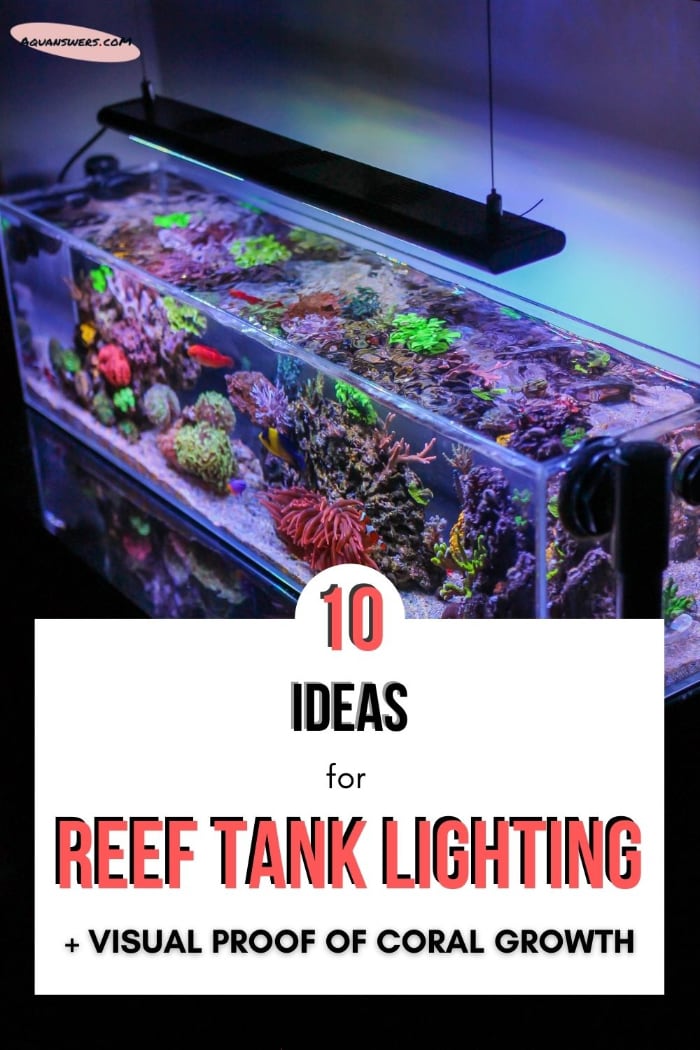
Drop me a comment below if there’s anything unclear or you just want to share your experience.

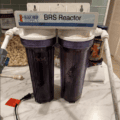
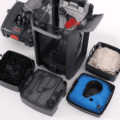
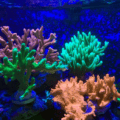


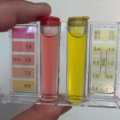
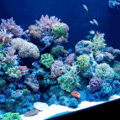
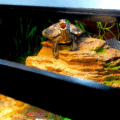

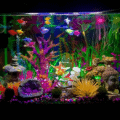
19 thoughts on “Best LED Aquarium Lighting for Reef Tank Corals (2023)”